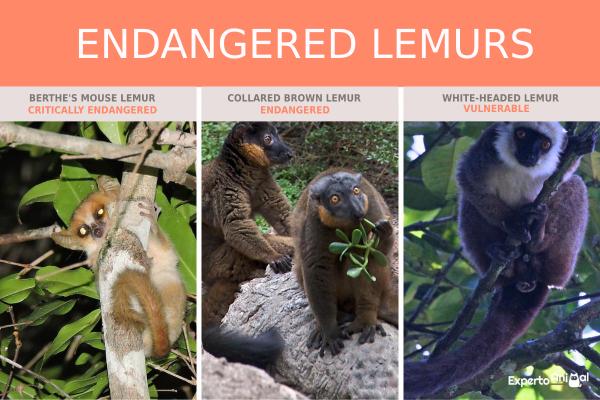Are Lemurs in Danger of Extinction?


The lemur is a primate are wet-nosed primates of the superfamily Lemuroidea that is only found in Madagascar. Their classification has been controversial, resulting in the identification of a wide variety of species and whose number has changed as research progresses.There are currently 33 species of lemurs that are classified as endangered, while 103 of the 107 remaining species are threatened with extinction.
In this AnimalWised article, we explore the question of whether lemurs are endangered, both as a way of reporting on their conservation status and to help raise awareness of the need to protect the planet.
Are lemurs in danger of extinction?
To answer this question, we can say that yes, there are species of lemurs that are in danger of extinction. Let us now list some of these species that are classified as critically endangered, endangered or vulnerable by the International Union for Conservation of Nature (IUCN).
Critically endangered lemurs:
- Sibree's dwarf lemur (Cheirogaleus sibreei)
- Madame Berthe's mouse lemur (Microcebus berthae)
- Bemanasy mouse lemur (Microcebus manitatra)
- Marohita mouse lemur (Microcebus marohita)
- Gray-headed lemur (Eulemur cinereiceps )
- Blue-eyed black lemur (Eulemur flavifrons)
- Lac Alaotra bamboo lemur (Hapalemur alaotrensis)
- Golden bamboo lemur (Hapalemur aureus)
- Greater bamboo lemur (Prolemur simus)
- Red ruffed lemur (Varecia rubra)
- Black-and-white ruffed lemur (Varecia variegata)
- Ahmanson's sporting lemur (Lepilemur ahmansonorum)
- Holland sport lemur (Lepilemur hollandorum)
- James's sportive lemur (Lepilemur jamesorum)
- Mittermeier's sportive lemur (Lepilemur mittermeieri)
- Red-tailed sport lemur (Lepilemur ruficaudatus)
- Sahamalaza sportive lemur (Lepilemur sahamalazensis)
- Northern sportive lemur (Lepilemur septentrionalis)
- Hawks' sportive lemur (Lepilemur tymerlachsoni)
- Bemaraha woolly lemur (Avahi cleesei)
Endangered lemurs:
- Hairy-eared dwarf lemur (Allocebus trichotis)
- Bongolava mouse lemur (Microcebus bongolavensis)
- Collared brown lemur (Eulemur collaris)
- Black lemur (Eulemur macaco)
- Ankarana sportive lemur (Lepilemur ankaranensis)
Lemurs in a vulnerable state:
- Furry-eared dwarf lemur (Cheirogaleus crossleyi)
- Pygmy mouse lemur (Microcebus myoxinus)
- White-headed lemur (Eulemur albifrons)
- Red lemur (Eulemur rufus)
- Seal's sportive lemur (Lepilemur seali)

Why is the lemur in danger of extinction?
In summary, there are many species of lemurs that are endangered, but they are all interconnected by the fact that humans are responsible for their plight. Next, we will explain the various causes of the lemur's current vulnerable state:
Habitat destruction
Lemur populations are threatened by the massive cutting of trees for charcoal production. It should be noted that lemurs are generally arboreal, so removing the vegetation cover in which they live irreversibly harms them.
In addition, there are other reasons behind the deterioration of the Madagascar's forests:
- Forest fires are an annual event in these forests.
- Deforestation is also practiced to grow certain agricultural crops or to raise livestock.
In both cases, the result is the same - the loss of vegetation and thus a drastic change in the habitat of the lemurs.
Poaching
Other threats to lemurs that have led to them becoming endangered have to do with hunting, as some species are consumed as food while others are sold as pets.
Some species have been severely decimated, either by lack of food, natural disasters, etc. An example of this is the grey-headed lemur (Eulemur cinereiceps), whose population plummeted in 1997 due to a cyclone that exacerbated the anthropogenic influences mentioned above.
Climate change
Several species of lemurs are affected by climate change, such as the Greater Bamboo Lemur (Prolemur simus). Lemurs of this species are not only affected by climatic variations, but also by the availability of food. Climate change prolongs droughts, which harms the bamboo (Cathariostachys madagascariensis), which is their main food source.
If you want to know more about the habitat of the lemurs, don't miss this article on where do lemurs live?
Lemur conservation plans
Lemurs, which are threatened with extinction, are the subject of some conservation plans. In general, these plans depend on the particular situation of each species, although the problems facing lemurs are common in all species. Let us take a look at the current plans:
- Several species of lemurs have been included in the Convention on International Trade in Endangered Species of Wild Fauna and Flora (CITES), which aims to protect endangered species through treaties with various countries. For example, all lemurs listed in Appendix I of CITES are excluded from hunting or capture and are under special management. Some cases that are included are: The Sibree Dwarf Lemur (Cheirogaleus sibreei), the Madame Berthe Mouse Lemur (Microcebus berthae), the Grey-headed Lemur (Eulemur cinereiceps) and the Blue-eyed Black Lemur (Eulemur flavifrons) , among others.
- Other measures for the conservation of lemurs are related to the establishment of protected areas in places where these animals live. In this sense, certain forest areas are declared reserves, most of which are private.
- Educational programs have been proposed to raise awareness among children and young people, such as the mouse lemur species Madame Berthe (Microcebus berthae), which is considered a showcase in some areas of Madagascar.
- There are also some special conservation programs, such as that of the greater bamboo lemur (Prolemur simus), for which the Saving Prolemur simus project was created. This project was established by private organizations and community members.
- Research to improve taxonomy should continue in situations where questions remain to be resolved regarding subspecies, such as Black-and-white ruffed lemur (Varecia variegate).
What can be done to prevent the lemur from becoming extinct?
Although the above measures have been taken, the list of endangered lemur species is still long, which shows that more needs to be done. In a situation as complex as this, government action is essential to halt the progression of these animals' endangerment. In addition, massive education programs are essential, as engaging the communities that inhabit these areas will undoubtedly produce supporters who are actively engaged in the conservation of the lemur species.
If you are interested in reading abut other animals that are currently facing the dangers of extinction, keep reading this article on the 10 animals in danger of extinction.
If you want to read similar articles to Are Lemurs in Danger of Extinction?, we recommend you visit our Endangered animals category.
- Andriaholinirina, N., and others. (2014). Microcebus marohita . The IUCN Red List of Threatened Species. Available at: https://dx.doi.org/10.2305/IUCN.UK.2014-1.RLTS.T46251646A46251651.en
- Blanco, M., Dolch, R., Ganzhorn, J., Greene, LK, Le Pors, B., Lewis, R., Louis, EE, Rafalinirina, HA, Raharivololona, B., Rakotoarisoa, G., Ralison, J., Randriahaingo, HNT, Rasoloarison, RM, Razafindrasolo, M., Sgarlata, GM, Wright, P. and Zaonarivelo, J. (2020). Cheirogaleus sibreei . The IUCN Red List of Threatened Species. Available at: https://dx.doi.org/10.2305/IUCN.UK.2020-2.RLTS.T41576A115579719.en
- Blanco, M., Dolch, R., Donati, G., Ganzhorn, J., Greene, LK, Le Pors, B., Lewis, R., Rafalinirina, HA, Raharivololona, B., Ralison, J., Randriahaingo , HNT, Rasoloarison, RM, Razafindrasolo, M., Sgarlata, GM, Wright, P. & Zaonarivelo, J. (2020). Microcebus manitatra . The IUCN Red List of Threatened Species 2020: e.T163313848A163313878. https://dx.doi.org/10.2305/IUCN.UK.2020-2.RLTS.T163313848A163313878.en
- Borgerson, C., Eppley, TM, Patel, E., Johnson, S., Louis, EE & Razafindramanana, J. (2020). Varecia rubra . The IUCN Red List of Threatened Species. Available at: https://dx.doi.org/10.2305/IUCN.UK.2020-2.RLTS.T22920A115574598.en
- Eppley, TM & Borgerson, C. (2020). Hapalemur alaotrensis (amended version of 2020 assessment) . The IUCN Red List of Threatened Species. Available at: https://dx.doi.org/10.2305/IUCN.UK.2020-3.RLTS.T9676A182236363.en
- Johnson, S., Andriamisedra, TR, Donohue, ME, Ralainasolo, FB, Birkinshaw, C., Ludovic, R. and Ratsimbazafy, J. (2020). Eulemur cinereiceps . The IUCN Red List of Threatened Species. Available at: https://dx.doi.org/10.2305/IUCN.UK.2020-2.RLTS.T8205A115562060.en
- Louis, EE, Sefczek, TM, Raharivololona, B., King, T., Morelli, TL & Baden, A. (2020). Varecia variegata . The IUCN Red List of Threatened Species. Available at: https://dx.doi.org/10.2305/IUCN.UK.2020-2.RLTS.T22918A115574178.en






